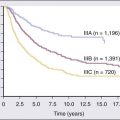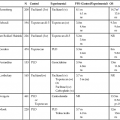16 Elaine S. Jaffe and James Vardiman • The World Health Organization (WHO) classification of hematologic neoplasms includes tumors of lymphoid, myeloid, histiocytic, and dendritic cell lineages. • Each disease is defined as a distinct entity based on a constellation of morphologic, clinical, and biological features. • The cell of origin is the starting point of disease definition. • Some lymphomas and leukemias can be identified by routine morphologic approaches. However, for many diseases, knowledge of the immunophenotype and molecular genetics/cytogenetics plays an important role in the differential diagnosis. • The sites of presentation and involvement are an important clue to underlying biological distinctions. Extranodal lymphomas differ in many respects from their nodal counterparts. • Many lymphoma entities display a range in cytologic grade and clinical aggressiveness, making it difficult to stratify lymphomas according to clinical behavior. A number of prognostic factors influence clinical outcome, including stage, international prognostic index, cytologic grade, gene expression profile, secondary genetic events, and the host environment. • The WHO classification includes five major categories of myeloid diseases, all of which are clonal stem cell disorders exhibiting variable maturation in the affected lineages and either effective or ineffective hematopoiesis: • Among myeloid neoplasms, genetic features predict behavior better than morphology alone, necessitating genetic studies for accurate diagnosis. In recent years, the discipline of hematopathology has emphasized the integration of morphology and biological markers for diagnosis. In this respect, the approaches used in hematologic diagnosis often have served as a model for other areas of pathology. For example, in the early 1980s, detection of rearrangements of the antigen receptor genes in lymphoid cells was used to indicate both clonality and cell lineage, long before molecular diagnostic techniques became commonplace in pathology. Biological approaches such as immunohistochemistry, cytogenetics, and molecular biology enhance diagnostic accuracy and play a critical role in the definition of disease entities.1 The earliest classification schemes for lymphomas—those proposed by Gall and Mallory2 and Rappaport3—were based on cytologic and architectural features. However, insights into the complexities of the normal immune system led to attempts to relate the lymphomas to their normal cellular counterparts. In the 1970s, efforts to establish an immunologically based classification were led largely by Karl Lennert and colleagues in Europe and by Lukes and Collins in the United States.1 Several European and American groups published proposals for the classification of lymphoma, and competing classification systems in use in clinical studies made it difficult to compare outcome data from different treatment centers.4–7 The inability of the pathologists to develop consensus and agree on a common approach led to the development of a working formulation for the non-Hodgkin lymphomas, after a National Cancer Institute–directed study was conducted to evaluate the six published schemes.8 The working formulation tried to stratify lymphomas according to clinical outcome based on clinical trials conducted in the 1970s.8 Its proponents believed that attempts to relate tumors to the normal immune system were premature, and in essence it was a morphologically based scheme, differing in only minor ways from the Rappaport classification, which had been in widespread use in the United States. A similar paradigm developed in the classification of acute myeloid and lymphoid leukemias. Earlier classification systems emphasized morphologic approaches, although the French–American–British (FAB) classification did use enzyme cytochemistry to identify cellular lineage and degree of maturation, at least within the myeloid and monocytic neoplasms.9 The categories of acute lymphoblastic leukemia—L1, L2, and L3—included both mature and immature lymphoid malignancies, because L3 was largely composed of mature blastic B cells similar to the cells of Burkitt lymphoma (BL). Although L1 and L2 were both of lymphoblastic origin, they correlated poorly with precursor T- or B-cell lineage. Modern immunophenotypic and molecular approaches for characterizing lymphoid and myeloid cells are now readily available. The use of these new biological approaches has transformed our understanding of hematologic neoplasia. Immunophenotypic, cytogenetic, and genotypic studies have permitted an impartial analysis of questions that were unresolved when addressed with only routinely stained sections or smears and have allowed the incorporation of objective criteria into the definition and diagnostic criteria for hematologic malignancies. Indeed, a broad international consensus has emerged on many topics. This consensus was embodied in the Revised European-American Classification of Lymphoid Neoplasms (REAL classification) published by the International Lymphoma Study Group in 199410 and was broadened to include myeloid and histiocytic neoplasms in the World Health Organization (WHO) classification.11 The REAL classification10 and its successor the WHO classification11 represented a new paradigm in the classification of lymphoid neoplasms. The focus was on the identification of “real” diseases, rather than a global theoretical framework, such as survival (working formulation), or cellular differentiation (Kiel classification). The REAL classification was based on the building of consensus and recognized that a comprehensive classification system was beyond the experience of any one individual. The WHO classification effort, which involved input from multiple experts, maintained this approach. The REAL classification departed from traditional schemes by emphasizing that each disease was a distinct entity defined by a constellation of laboratory and clinical features—that is, morphology, immunophenotype, genetic features, clinical presentation, and course. The inclusion of clinical criteria was one of the more novel aspects of the International Lymphoma Study Group approach. The REAL classification recognized that the site of presentation is often a signpost for underlying biological distinctions, as in extranodal lymphomas of the mucosal-associated lymphoid tissues12 or many forms of T-cell lymphoma.13 Accurate diagnosis requires knowledge of the clinical history, because biologically distinct entities may appear cytologically similar. Moreover, within a given disease entity, a number of prognostic factors influence the clinical outcome. Cytologic grade is one type of prognostic factor and is used in the stratification of follicular lymphoma. Clinical features, such as the stage or international prognostic index, also markedly affect survival and response to treatment.14,15 For these reasons, it is not possible to stratify lymphoma subtypes according to clinical grade. Moreover, clinical groupings for either protocol treatment or routine clinical practice are generally not feasible. In evaluating new therapies, the data for each disease must be evaluated individually. Indeed, treatment approaches for one type of lymphoid malignancy are not necessarily applicable to other diseases, even of the same cell lineage. This point is exemplified by hairy cell leukemia, a rare disease for which highly effective forms of therapy have been developed.16 However, the purine analogues 2′ deoxycoformycin and 2′-chlorodeoxyadenosine have not been similarly effective in treating other B-cell leukemias and lymphomas. The REAL classification was the first to emphasize the importance of molecular oncology in defining disease entities. Cancer is increasingly recognized as a genetic disease.17 For many lymphomas, a good correlation exists between the molecular pathogenesis and routine histologic and immunophenotypic features. For example, the t(14;18) translocation involving the BCL2 and IGH@ genes is highly associated with follicular lymphoma diagnosed by routine methods. In addition, the recognition of some molecular phenotypes can be recognized by immunohistochemistry, such as cyclin D1 overexpression in the diagnosis of mantle cell lymphoma, or anaplastic lymphoma kinase (ALK) expression in anaplastic large cell lymphoma. Variations in the genetic complexity score also have been shown to influence clinical outcome, with pediatric lymphomas generally having many fewer genetic anomalies than adult lymphomas.18,19 Subsequent studies affirmed the principles of the REAL classification.20 The use of precise disease definitions enhanced diagnostic accuracy and reduced inter-observer variability. The significance of identifying individual disease entities was confirmed by overall survival and failure-free survival data. Precise disease definitions have also facilitated the discovery of the molecular pathogenesis of lymphomas and leukemias. Many pathogenetic insights have followed on the heels of the identification of a disease along clinical lines (Table 16-1). Moreover, advances in therapy are best achieved when studies are conducted on a homogeneous disease entity. For example, the approaches to therapy of extranodal marginal B-cell lymphoma of mucosal-associated lymphoid tissues type differ from those of more systemic small B-cell malignancies. The ultimate goal in this model is molecularly targeted therapy, directed at the genomic alterations specific to the tumor. Table 16-1 Representative Pathogenetic Insights Based on a Disease-Oriented Approach to Lymphoma Classification In 2001 the International Agency for Research on Cancer, under the auspices of the WHO, published a unified and internationally accepted classification scheme for all lymphoid, myeloid, histiocytic, and dendritic cell neoplasms.11 The WHO monograph was part of a series encompassing all human neoplasms, with the goal to integrate pathology diagnosis with genetics to arrive at biologically relevant classification systems. The WHO adopted the approach of the REAL classification for the lymphoid malignancies, because this approach had been validated, and in turn applied the same principles to tumors of other hematopoietic lineages, mainly myeloid and histiocytic tumors. The latest edition of the WHO classification, which was published in 2008 (Box 16-1), incorporates many new advances from studies in recent years.21,22 For example, molecular profiling studies are leading to better delineation of aggressive B-cell lymphomas.23,24 Gene expression profiling studies identified two broad categories of DLBCL, with one group resembling germinal center B cells and a second group resembling activated peripheral blood B cells (ABCs). These studies are providing insights into the molecular pathways that are primarily deregulated in these tumors. For example, the ABC type of DLBCL is associated with activation of the nuclear factor (NF) κB pathway and deregulation of B-cell signaling.25 The importance of the host response and the tumor microenvironment has also been shown to be important in predicting outcome.26,27 The microenvironment also has been shown to influence prognosis in follicular lymphoma, independent of cytologic grade.28,29 These data additionally confirm that neoplastic lymphoid cells are still responses to immunoregulatory factors.
WHO Classification of Hematologic Malignancies
 Myeloid (and lymphoid) neoplasms with eosinophilia and abnormalities of PDGFRA, PDGFRB, or FGFR1
Myeloid (and lymphoid) neoplasms with eosinophilia and abnormalities of PDGFRA, PDGFRB, or FGFR1
 Myelodysplastic/myeloproliferative neoplasms
Myelodysplastic/myeloproliferative neoplasms
Introduction
Historical Background
The Next Steps for Lymphoma: REAL to WHO
Disease
Pathogenesis
Adult T-cell leukemia/lymphoma
HTLV-I
Extranodal NK/T-cell lymphoma, nasal type
EBV, genetics
Anaplastic large cell lymphoma
ALK
Mantle cell lymphoma
CCND1
Follicular lymphoma
BCL2
MALT lymphoma
Helicobacter, MALT1
Burkitt lymphoma
MYC
Primary effusion lymphoma
HHV-8/KSHV
The 2008 WHO Classification for Lymphomas












